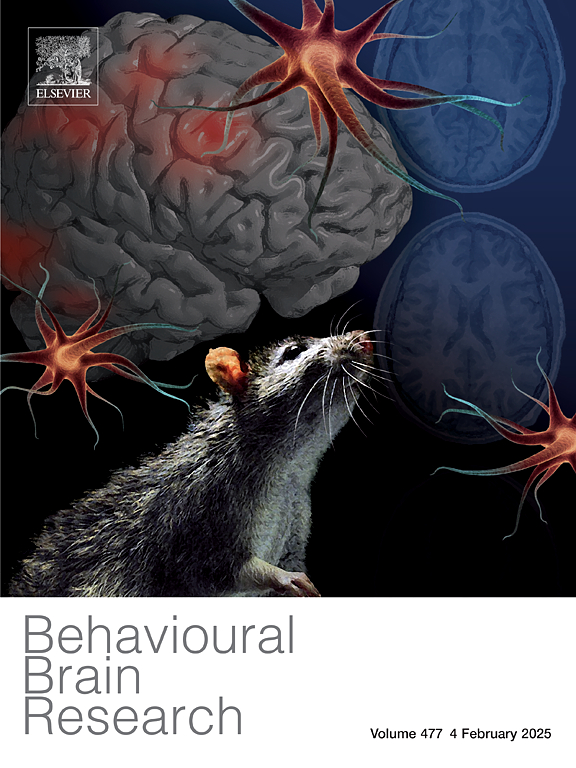Effects of High-Intensity Interval Training (HIIT) on miR-29c and miR-146a expression in the hippocampus of streptozotocin-induced diabetic rats
IF 2.3
3区 心理学
Q2 BEHAVIORAL SCIENCES
引用次数: 0
Abstract
Background
MicroRNAs like miR-146a and miR-29c are potential biomarkers for diabetes, which is linked to brain impairments such as cognitive decline and hippocampal dysfunction due to hyperglycemia and inflammation. This study investigates the effects of high-intensity interval training (HIIT) on hippocampal miR-146a and miR-29c expression and serum TNF-α levels in diabetic rats, highlighting its role in reducing inflammation and improving brain function.
Methods
Twenty-four male Wistar rats were divided into four groups: Control (Normal), 1-week diabetes (Diabetes 1 W), 6-week diabetes (Diabetes 6 W), and diabetic HIIT (Diabetes-Exe). Diabetes was induced using streptozotocin (55 mg/kg) and rats with blood glucose > 250 mg/dL were included. HIIT was conducted for six weeks, and hippocampal miR-146a, miR-29c expression, and TNF-α serum levels were assessed using Real-Time PCR and ELISA. TNF-α serum levels were measured as a marker of systemic inflammation.
Results
Diabetic rats exhibited decreased miR-146a and increased miR-29c expression in the hippocampus compared to controls. Additionally, TNF-α serum levels were significantly higher in the diabetic groups, indicating an elevated inflammatory state. HIIT in the Diabetes-Exe group resulted in a non-significant change in miR-29c expression and TNF-α serum levels, accompanied by a significant increase in miR-146a expression compared to the Diabetes 6 W group.
Conclusion
HIIT exercise may help reduce hippocampal neuronal damage in diabetic rats by modulating miR-146a expression, improving blood glucose control, and reducing inflammation. Although HIIT did not significantly alter miR-29c expression, its potential as an effective non-pharmacological strategy for managing diabetic neuropathy complications cannot be excluded.
高强度间歇训练(HIIT)对链脲霉素诱导的糖尿病大鼠海马中miR-29c和miR-146a表达的影响
miR-146a和miR-29c等microrna是糖尿病的潜在生物标志物,与高血糖和炎症引起的认知能力下降和海马功能障碍等脑损伤有关。本研究探讨了高强度间歇训练(HIIT)对糖尿病大鼠海马miR-146a和miR-29c表达及血清TNF-α水平的影响,强调其在减轻炎症和改善脑功能中的作用。方法24只雄性Wistar大鼠分为4组:对照组(Normal)、1周糖尿病(diabetes 1 W)、6周糖尿病(diabetes 6 W)和糖尿病HIIT (diabetes - exe)。采用链脲佐菌素(55 mg/kg)诱导糖尿病,纳入血糖>; 250 mg/dL的大鼠。HIIT进行6周,使用Real-Time PCR和ELISA评估海马miR-146a、miR-29c表达和TNF-α血清水平。血清TNF-α水平作为全身性炎症的标志。结果与对照组相比,糖尿病大鼠海马中miR-146a表达降低,miR-29c表达升高。此外,糖尿病组血清TNF-α水平显著升高,表明炎症状态升高。糖尿病- exe组的HIIT导致miR-29c表达和TNF-α血清水平无显著变化,与糖尿病6 W组相比,miR-146a表达显著增加。结论hiit运动可能通过调节miR-146a表达,改善血糖控制,减轻炎症反应,从而减轻糖尿病大鼠海马神经元损伤。虽然HIIT并没有显著改变miR-29c的表达,但不能排除其作为治疗糖尿病神经病变并发症的有效非药物策略的潜力。
本文章由计算机程序翻译,如有差异,请以英文原文为准。
求助全文
约1分钟内获得全文
求助全文
来源期刊

Behavioural Brain Research
医学-行为科学
CiteScore
5.60
自引率
0.00%
发文量
383
审稿时长
61 days
期刊介绍:
Behavioural Brain Research is an international, interdisciplinary journal dedicated to the publication of articles in the field of behavioural neuroscience, broadly defined. Contributions from the entire range of disciplines that comprise the neurosciences, behavioural sciences or cognitive sciences are appropriate, as long as the goal is to delineate the neural mechanisms underlying behaviour. Thus, studies may range from neurophysiological, neuroanatomical, neurochemical or neuropharmacological analysis of brain-behaviour relations, including the use of molecular genetic or behavioural genetic approaches, to studies that involve the use of brain imaging techniques, to neuroethological studies. Reports of original research, of major methodological advances, or of novel conceptual approaches are all encouraged. The journal will also consider critical reviews on selected topics.
 求助内容:
求助内容: 应助结果提醒方式:
应助结果提醒方式:


